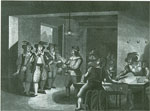 Milan as the cultural capital Milan as the cultural capital
During the Napoleonic era and later under the restored Austrian government, Milan became Italy’s liveliest and most visited cultural centre, drawing intellectuals and literary figures from all over Italy who saw it as the only place where they could work and at the same time gain wealth and satisfaction from their work. One famous example was the young Leopardi in the isolated province of the Papal State who watched on with envy at the numerous cultural activities that were taking place in Milan, writing as follows to the Abbot Francesco Cancellieri: “Whoever has the good fortune to be in Milan can publish anything they want, with the costs covered by the publishers or with certainty of outcome […]. Everyone publishes, while we miserable wretches are prevented from publishing anything.” In Milan, a solid publishing industry had sprung up, with an unprecedented market for books compared to other Italian cities. In the Proemio to his pro-Austrian Biblioteca Italiana, editor Giuseppe Acerbi was able to claim that Milanese publishing had absolute supremacy, producing 653 titles in 1816 compared to the 114 titles of the entire Kingdom of Naples. One of the most important and successful initiatives was the Società tipografica dei classici italiani, set up at the beginning of the century under the auspices of the government of the “Italian Republic” with the aim of publishing a substantial collection of authors in celebration of Italy’s national culture. The twelve years it took to publish the 249 volumes of the Collezione also turned out to be a sound business venture, thanks to the modern capitalist criteria adopted by the publishing company (such as a number of luxury editions and a fast production rate that sustained the flow of money). Milan’s Società tipografica provided the future major publishers of nineteenth century Milan with their first experiences: Giovanni Silvestri, Anton Fortunato Stella (publisher of Leopardi’s Operette Morali in 1827), and Vincenzo Ferrario (publisher of works by Manzoni).

Le vetrine di Antonio Vallardi e di Giovanni Silvestri in contrada Santa Margherita a Milano [in Marino Berengo, Intellettuali e librai nella Milano della Restaurazione, Turin, Einaudi, 1980]

|